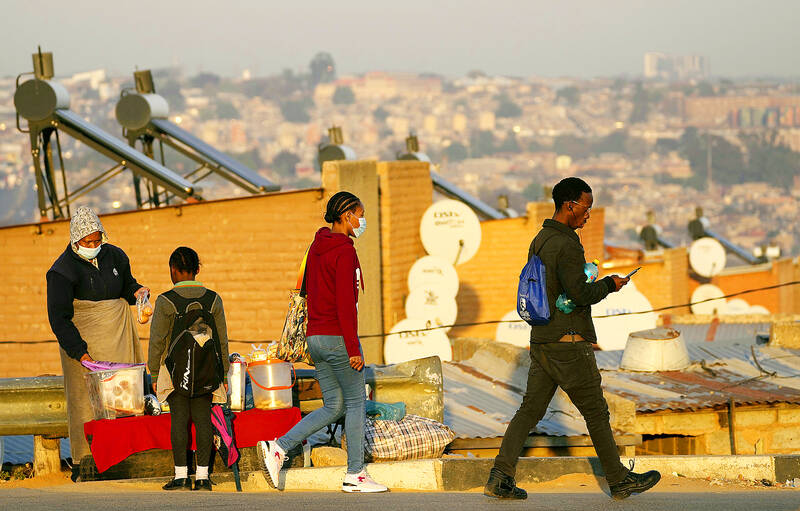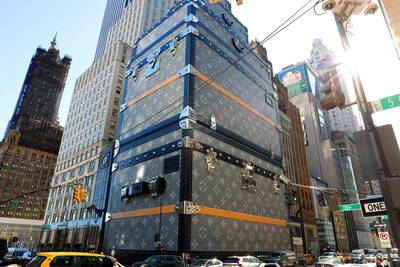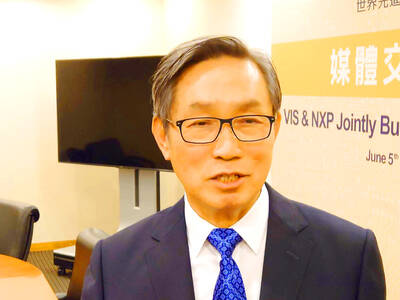For more than a decade, musician Thomas Nhassavele has been busking next to the parking payment machine at Johannesburg’s Rosebank Mall, where drivers often dropped their change into his guitar case.
However, Nhassavele’s takings have dwindled in the past few years as growing numbers of mall visitors use cards to pay at the machine’s new cashless payment system — some mumbling a quick apology to him before they head for the exits.
“There has been about a 50 percent reduction in donations since the mall installed cashless ticket payments. Many people just don’t want to carry money anymore,” he said, strumming his guitar.

Photo: AP
Cashless payments in the country are on the rise as customers are drawn to the convenience, safety and hygiene of tapping a card or scanning a QR code in post-COVID-19, crime-ridden South Africa — sometimes at the expense of the informal economy.
While analysts say the cashless move has boosted sales for small businesses, those dependent on loose change — buskers, street traders or fuel station attendants who rely on tips — say the shift has hit their earnings.
From Ghana to Kenya, the 59 billion cashless transactions carried out in Africa in 2020 are expected to nearly triple by 2030 to reach 172 billion, a report by PricewaterhouseCoopers (PwC) showed.
“We must accept that technology will change things, but I fear this cashless world will kill our income,” Nhassavele said, as a customer dropped a 1 rand (US$0.05) coin into his guitar case.
Smartphone penetration in South Africa has grown from 48 to 78 percent in the past four years, while the number of South Africans over the age of 15 with bank accounts rose from 54 percent in 2011 to 84 percent last year, World Bank data showed.
This lays a strong foundation for cashless payments, said Michael Thomson, creative director at SnapScan, a contactless QR code payment system that caters to 70,000 merchants across the country, and has 3 million downloads.
There are still barriers to increasing uptake.
While women in South Africa are more likely to have bank accounts than their peers in other countries in the region, a lack of financial literacy and discrimination keeps them from accessing the full potential of banking resources and opportunities, University of Johannesburg research showed.
Navigating cashless systems typically requires a bank account, a cellphone number, Internet access and digital literacy — not all of which are available to those without identification documents or smartphones, including refugees and the homeless.
“The formal payment system and its innovations tend to be utilized by the higher-income markets rather than the lower-income or under-developed sectors of the economy,” said Chantal Maritz, head of PwC’s strategy and payments team in South Africa.
Nearly 30 percent of South Africa’s economy is informal, the World Economics data Web site showed.
Of the South Africans with bank accounts, 25 percent — or 8.3 million people — are underbanked, meaning they cannot access full banking services, Maritz said.
“Although digital payments don’t require a bank account, such street vendors, buskers and beggars would require a digital store of value that holds their digital money to make and accept payments,” she said.
That could include a bank-linked e-wallet.
Another group of workers feeling the cashless pinch in South Africa are fuel station attendants who fill up customers’ vehicles, clean the windscreen and then — if the customer wants to pay on a card — bring the payment terminal to the driver.
“Drivers want to tap and go. This is bad for us as tips don’t always come when people use cards,” said Lebogang Ramathoka, an attendant at a Johannesburg gas station, adding that tips had earlier made up more than 30 percent of his monthly wage.
Some gas stations have started letting customers add a tip to their card payment, Ramathoka said.
“There should be an option on the card machine that asks them if they want to add a tip for us. It’s less awkward than us having to ask them,” he said, sipping a drink at a table behind the petrol station during his break.
A slew of other payment options aimed at popularizing cashless payments have been launched in the past few years, from First National Bank’s e-wallet that lets customers send money to a cellphone number, to Yoco’s wireless card machine and Zapper and SnapScan’s QR codes.
Yoco is a portable South African card machine used by 250,000 South African businesses that connects to a cellphone over bluetooth, and offers free, unlimited 4G data and WiFi connectivity, taking less than a 3 percent fee on payments.
Yoco and SnapScan say that car guards — people who watch over parked vehicles to ensure they are not stolen — who have bank accounts have begun giving drivers the options of cashless Yoco and SnapScan payments.
Timothy, a waste picker who also cleans the streets at traffic lights in Johannesburg, said his cellphone was his saving grace during COVID-19 lockdowns, as he could ask contacts to send him cash to his e-wallet.
“It’s the reason I survived,” he said, asking to only use his first name to protect his identity.
“Easier access to [the] identification documents and proof of address” needed to get bank accounts, digital wallets and SIM cards, would also open up cashless payment systems to marginalized groups, Thomson said.
However, gas station attendants such as Ramathoka hope the surge in cashless payments will not do away with cash altogether.
“People are on tight budgets, and a coin here or there is easier to give than swiping on a card,” he said. “If there are no coins to give, I fear we will struggle.”

STEEP DECLINE: Yesterday’s drop was the third-steepest in its history, the steepest being Monday’s drop in the wake of the tariff announcement on Wednesday last week Taiwanese stocks continued their heavy sell-off yesterday, as concerns over US tariffs and unwinding of leveraged bets weighed on the market. The benchmark TAIEX plunged 1,068.19 points, or 5.79 percent, to 17,391.76, notching the biggest drop among Asian peers as it hit a 15-month low. The decline came even after the government on late Tuesday authorized the NT$500 billion (US$15.2 billion) National Stabilization Fund (國安基金) to step in to buoy the market amid investors’ worries over tariffs imposed by US President Donald Trump. Yesterday’s decline was the third-steepest in its history, trailing only the declines of 2,065.87 points on Monday and

TAKING STOCK: A Taiwanese cookware firm in Vietnam urged customers to assess inventory or place orders early so shipments can reach the US while tariffs are paused Taiwanese businesses in Vietnam are exploring alternatives after the White House imposed a 46 percent import duty on Vietnamese goods, following US President Donald Trump’s announcement of “reciprocal” tariffs on the US’ trading partners. Lo Shih-liang (羅世良), chairman of Brico Industry Co (裕茂工業), a Taiwanese company that manufactures cast iron cookware and stove components in Vietnam, said that more than 40 percent of his business was tied to the US market, describing the constant US policy shifts as an emotional roller coaster. “I work during the day and stay up all night watching the news. I’ve been following US news until 3am

Six years ago, LVMH’s billionaire CEO Bernard Arnault and US President Donald Trump cut the blue ribbon on a factory in rural Texas that would make designer handbags for Louis Vuitton, one of the world’s best-known luxury brands. However, since the high-profile opening, the factory has faced a host of problems limiting production, 11 former Louis Vuitton employees said. The site has consistently ranked among the worst-performing for Louis Vuitton globally, “significantly” underperforming other facilities, said three former Louis Vuitton workers and a senior industry source, who cited internal rankings shared with staff. The plant’s problems — which have not

TARIFF CONCERNS: The chipmaker cited global uncertainty from US tariffs and a weakening economic outlook, but said its Singapore expansion remains on track Vanguard International Semiconductor Corp (世界先進), a foundry service provider specializing in producing power management and display driver chips, yesterday withdrew its full-year revenue projection of moderate growth for this year, as escalating US tariff tensions raised uncertainty and concern about a potential economic recession. The Hsinchu-based chipmaker in February said revenues this year would grow mildly from last year based on improving supply chain inventory levels and market demand. At the time, it also anticipated gradual quarter revenue growth. However, the US’ sweeping tariff policy has upended the industry’s supply chains and weakened economic prospects for the world economy, it said. “Now